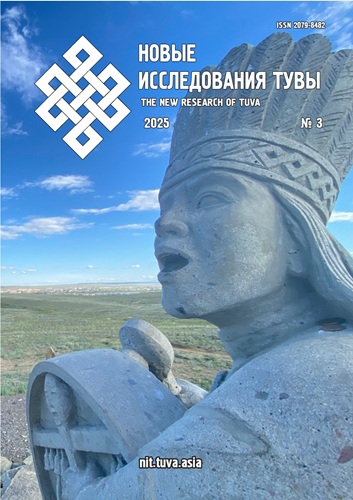Animal Images in Tuvan and Kyrgyz Fairy Tales in Soviet Russian-Language Translated Editions
DOI:
https://doi.org/10.25178/nit.2025.3.19Keywords:
Tuvan folklore; Tuvan fairy tale; Kyrgyz folklore; Kyrgyz fairy tale; animal image; image of the fox; image of the hare; image of the wolfAbstract
This article examines the images of animals in Tuvan and Kyrgyz folk tales published as Russian-language translations during the Soviet period. The comparative analysis of animal images is conducted with consideration of the corresponding prism of Russian linguistic culture. The relevance and novelty of the study lie not so much in identifying animal images in the fairy tales of the two related linguistic cultures but rather in analyzing the unification of artistic perception of the imagistic range within a single Russian linguistic culture.
The most popular fairy tale animals in the analyzed translated fairy tales of the two ethnic cultures are the fox, the hare, and the wolf.
In the Russian interpretation of Tuvan tales, the image of the fox is conveyed through its craftiness and is represented within the characteristic of being “cunning”, whereas in the Russian-language translations of Kyrgyz tales, it centers around the concepts of “deception” and “punishment”, which ultimately lead to the characterization of the fox as “punished”. The image of the hare in the Russian translations of Tuvan and Kyrgyz tales is presented from two perspectives: the first — boastfulness, leading to the characterization of “bluffing”, and resourcefulness, which ensures the functioning of the characteristic “clever” within Russian linguistic culture. The naivety and gullibility of the wolf in translations of both Tuvan and Kyrgyz tales into Russian is defined by the general characterization as “stupid”.
References
Aleksandrova, E. A. (2011) Studying traditional ethnic culture through semiotic analysis of fairy-tale characters (the image of the fox in Russian and Chinese traditions). Analitika Kul'turologii, no. 1 (19), pp. 230–234. (In Russ.)
Vorontsova, G. N. and Gasanov, M. M. (2022) Ethnolinguomarkers in translated texts of Tuvan folk tales: linguocultural commentary. New Research of Tuva, no. 1, pp. 104–114. (In Russ.) DOI: https://doi.org/10.25178/nit.2022.1.7
Zhalalova, D. T. and Aripova, G. S. (2020) The concept of “fox” in the language picture of the world of the Kyrgyz, Russian and Uzbek peoples. Actual Problems of Social, Humanitarian and Scientific-Technical Knowledge, no. 4 (24), pp. 29–32. (In Russ.)
Zalesova, N. M. (2017) The concept of “deception” and its actualization in the artistic picture of the world (based on the material of John Fowles' novel “The Magus”). Izvestiya Volgogradskogo Gosudarstvennogo Pedagogicheskogo Universiteta, no. 5 (118), pp. 114–120. (In Russ.)
Zolotukhina, I. P. and Biche-ool, A. A. (2024) Literary works as a means of forming ideas about wild animals in older preschool children. Alleya Nauki, vol. 1, no. 4 (91), pp. 961–964. (In Russ.)
Krasilnikova, E. I. and Troyak, I. S. (2025) Publications of Tuvan fairy tales and heroic epics in Russian during the Soviet period: the aspect of memory policy. New Research of Tuva, no. 1, pp. 26–38. (In Russ.) DOI: https://doi.org/10.25178/nit.2025.1.2
Kuzhuget, Sh. Yu. (2018) Folkloric origins of satire in Tuvan prose. Filologicheskie Nauki. Voprosy Teorii i Praktiki, no. 7–1 (85), pp. 41–46. (In Russ.) DOI: https://doi.org/10.30853/filnauki.2018-7-1.9
Kuzhuget, Sh. Yu., Suvandii, N. D. and Lamazhaa, Ch. K. (2021) Problems of translating cultural concepts into another language: the example of Tuvan cultural concepts. Polilingvial'nost' i Transkul'turnye Praktiki, vol. 18, no. 4, pp. 405–420. (In Russ.) DOI: https://doi.org/10.22363/2618-897X-2021-18-4-405-420
Kungaa, M. B. (2012) New collection of Tuvan fairy tales in Tuvan language. New Research of Tuva, no. 4, pp. 215–216. (In Russ.)
Lopatkina, S. V. (2021) Tuvan fairy tales as a way of immersion into the conceptual sphere of regional culture when teaching Russian as a foreign language at an advanced level. In: Regional Picture of the World in Linguistic Conceptualization: Universal and Unique, ed. by E. A. Gorobets. Kazan, Kazan (Volga Region) Federal University. 127 p. Pp. 52–60. (In Russ.)
Myasnikova, Yu. V. (2020) Russian resourcefulness: the content of an ethnospecific concept. Trends in the Development of Science and Education, no. 59–3, pp. 77–81. (In Russ.) DOI: https://doi.org/10.18411/lj-03-2020-55
Propp, V. Ya. (1928) Morphology of the Folktale. Leningrad, Academia. 151 p. (In Russ.)
Ratnik, S. D. (2011) The concept of punishment in the semantic field in connection with other concepts. Vestnik Samarskogo Yuridicheskogo Instituta, no. 3 (5), pp. 36–39. (In Russ.)
Russian Cultural Space (2004). Vol. 1: Zoomorphic Images. Precedent Names. Precedent Texts. Precedent Statements, ed. by I. S. Bryleva, N. P. Volskaya, D. B. Gudkov, et al.; eds. I. V. Zakharenko et al. Moscow, Gnozis, 315 p. (In Russ.)
Subakozhoeva, Ch. T. (2022) On the experience of translating the Kyrgyz heroic epic “Manas”. Vestnik Dagestanskogo Gosudarstvennogo Universiteta. Series 2: Humanities, vol. 37, no. 2, pp. 83–94. (In Russ.) DOI: https://doi.org/10.21779/2542-0313-2022-37-2-83-94
Sultanova, Zh. O. (2023) Media interpretations of fairy-tale images for a children's audience (based on materials from Siberian and Kyrgyz folk tales and audio podcasts). Vestnik Kyrgyzsko-Rossiyskogo Slavyanskogo Universiteta, vol. 23, no. 6, pp. 173–188. (In Russ.) DOI: https://doi.org/10.36979/1694-500X-2023-23-6-173-188
Tabernilya-Basabe, A. E. (2018) The phenomenon of “bluff” in the context of insincere behavior. Linguistic Discourse in Social Practice: Collection of Scientific Works of the International Scientific and Practical Conference. Eds. N. A. Komina, I. V. Dorofeeva. Tver, Tver State University. 236 p. Pp. 198–201. (In Russ.)
Khairullina, A. R. and Sagitova, A. G. (2022) Linguistic picture of the world in everyday fairy tales of the Turkic peoples of Siberia (based on Yakut and Tuvan fairy tales). Vestnik Bashkirskogo Universiteta, vol. 27, no. 4, pp. 1062–1067. (In Russ.) DOI: https://doi.org/10.33184/bulletin-bsu-2022.4.41
Khertek, L. K. (2008) Symbolism of the white hare and the Bear in the traditional culture of the Tuvans. Vestnik Moskovskogo Gosudarstvennogo Universiteta Kul'tury i Iskusstv, no. 6, pp. 97–100. (In Russ.)
Khisamitdinova, F. G. (2010) Mythological Dictionary of the Bashkir Language. Moscow, Nauka. 452 p. (In Russ.)
Khomushku, A. O. (2017) On the main characters in English and Tuvan animal tales. In: Best Student Article 2017: Collection of Articles of the XI International Scientific and Practical Competition, ed. by G. Yu. Gulyaev. Penza, Nauka i Prosveshchenie. Vol. 3. 218 p. Pp. 157–160. (In Russ.)
Chumbaeva, A. S. and Bakaeva, E. P. (2023) On the image of the wolf in Kalmyk fairy tales. Bulletin of the Kalmyk Scientific Center RAS, no. 4, pp. 152–172. (In Russ.) DOI: https://doi.org/10.22162/2587-6503-2023-4-28-152-172
Sherbaeva, Zh. R. (2016) Some tasks of studying fairy tales in the training of primary school teachers. Izvestiya Vuzov Kyrgyzstana, no. 8–1, pp. 78–79. (In Russ.)
Sherbaeva, Zh. R. (2018) Formation of moral values in primary school pupils through animal fairy tales. Ural'skii Filologicheskii Vestnik. Series: Language. System. Personality: Linguistics of Creativity, no. 2, pp. 484–490. (In Russ.)
Sherbaeva, Zh. R. (2021) Specifics of the world of fairy tales in a child's perception. Bulletin of Science and Practice, vol. 7, no. 8, pp. 319–324. (In Russ.) DOI: https://doi.org/10.33619/2414-2948/69/36
Yakovleva, S. L. (2012) The concept of “punishment” in the proverbial picture of the world of the English language. Yazyk i Kul'tura, no. 1–2, pp. 243–249. (In Russ.)
Koopal, A. and Rangraz, S. (2023) The Effect of Transformation on Changing the Role of Characters in a Selection of Folk Tales. Literary Text Research, no. 27 (97), pp. 41–70. (In Persian). DOI: https://doi.org/10.22054/LTR.2021.48431.2879
Roth, K. (1998) Crossing boundaries: the translation and cultural adaptation of folk narratives. Fabula, vol. 39, no. 3–4, pp. 243–255. DOI: https://doi.org/10.1515/FABL.1998.39.3-4.243
White, M. D. and Marsh, E. (2006) Content Analysis: A Flexible Methodology. Library Trends, vol. 55, no. 1, pp. 22–45.
Published
How to Cite
For citation:
Sultanova Zh. O. Animal Images in Tuvan and Kyrgyz Fairy Tales in Soviet Russian-Language Translated Editions. New Research of Tuva, 2025, no. 3, pp. 317-332. (In Russ.). DOI: https://doi.org/10.25178/nit.2025.3.19
Issue
Section

This work is licensed under a Creative Commons Attribution-NonCommercial 4.0 International License.

Author(s) license holder(s) grant rights for their work to the journal (grantee of a license) under the simple non-exclusive open license in accordance with Art. 1286.1 «Open license for a research work, work of literature or fine arts», Civil Code of the Russian Federation.
New Research of Tuva publishes articles under the Creative Commons Attribution-NonCommercial license (CC BY-NC).
Since it is an open license, author(s) reserve the right to upload the article to their institutional repository, submit it to another journal (if it allows republications), or republish it on their own website (in full, or in part).
However, several conditions apply here:
a) The republished version must always contain the name(s) and affiliation(s) of the author(s), the original title and the hyperlink to the original version on the New Research of Tuva website;
b) It must be in open access, free of charge, and no category of readers must be in any way whatsoever advantaged over general readership.
c) should the contribution be submitted elsewhere by its author(s) without substantial modification (30% or more of original text unchanged), the body of the article should contain a disclaimer that the original version was published in New Research of Tuva (with a link to the respective page)
The CC-BY-NC is a non-revocable license which applies worldwide and lasts for the duration of the work’s copyright.









